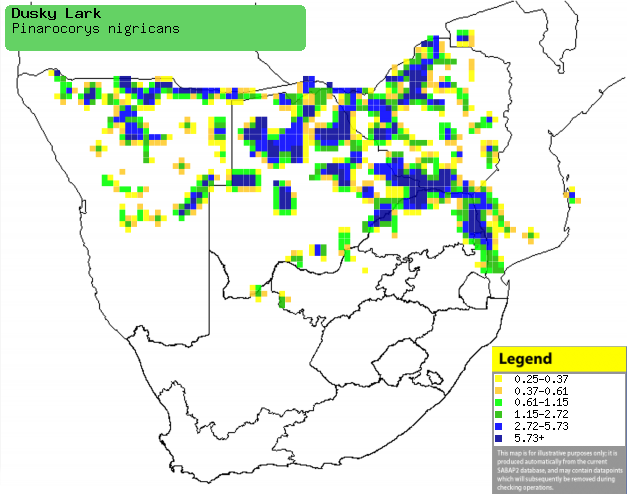|
Pinarocorys nigricans (Dusky
lark)
Donkerlewerik [Afrikaans]; Yisimatuli (generic term for
lark) [Kwangali]; Xihelagadzi (generic term for lark or pipit) [Tsonga];
Lijsterleeuwerik [Dutch]; Alouette brune [French]; Drossellerche [German];
Cotovia-sombria [Portuguese]
Life
> Eukaryotes >
Opisthokonta
> Metazoa (animals) >
Bilateria >
Deuterostomia > Chordata >
Craniata > Vertebrata (vertebrates) > Gnathostomata (jawed
vertebrates) > Teleostomi (teleost fish) > Osteichthyes (bony fish) > Class:
Sarcopterygii (lobe-finned
fish) > Stegocephalia (terrestrial
vertebrates) > Tetrapoda
(four-legged vertebrates) > Reptiliomorpha > Amniota >
Reptilia (reptiles) >
Romeriida > Diapsida > Archosauromorpha > Archosauria >
Dinosauria
(dinosaurs) > Saurischia > Theropoda (bipedal predatory dinosaurs) >
Coelurosauria > Maniraptora > Aves
(birds) >
Order: Passeriformes > Family: Alaudidae
Distribution and habitat
Its breeding grounds stretch from Tanzana through DRC to
northern Zambia and Angola; in the non-breeding season it heads south to
southern Africa. Here it is locally fairly common in mesic and semi-arid savanna
and woodland, especially grassy patches bordering on bushwillows (Combretum)
or other mixed woodland such as Mopane (Colosphermum mopane). It
may also occupy heavily grazed cattle paddocks and gravel roads in savanna.
|
 |
|
Distribution of Dusky lark in southern Africa,
based on statistical smoothing of the records from first SA Bird Atlas
Project (©
Animal Demography unit, University of
Cape Town; smoothing by Birgit Erni and Francesca Little). Colours range
from dark blue (most common) through to yellow (least common).
See here for the latest distribution
from the SABAP2. |
Movements and migrations
Intra-African breeding migrant, breeding in
winter in the miombo (Brachystegia) woodlands of central
Africa and moving in small groups (occasionally large flocks) south
to southern Africa in summer, arriving around October-December. It
eventually leaves the region in the period from April-June.
Food
It eats insects supplemented with seeds, doing most of its
foraging on the ground, plucking food items from soil, cow or antelope dung and
the bases of grass tufts. It is quite an opportunistic feeder, taking insects
flushed by grazing mammals, breaking open dead branches in search of termites. The following food items have been recorded
in its diet:
Threats
Not threatened.
References
-
Hockey PAR, Dean WRJ and Ryan PG 2005. Roberts
- Birds of southern Africa, VIIth ed. The Trustees of the John Voelcker
Bird Book Fund, Cape Town.
|
